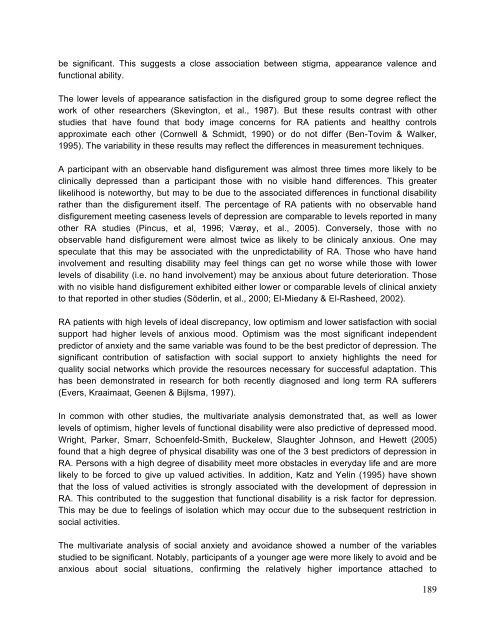Download the report - The Healing Foundation
Download the report - The Healing Foundation
Download the report - The Healing Foundation
Create successful ePaper yourself
Turn your PDF publications into a flip-book with our unique Google optimized e-Paper software.
e significant. This suggests a close association between stigma, appearance valence and<br />
functional ability.<br />
<strong>The</strong> lower levels of appearance satisfaction in <strong>the</strong> disfigured group to some degree reflect <strong>the</strong><br />
work of o<strong>the</strong>r researchers (Skevington, et al., 1987). But <strong>the</strong>se results contrast with o<strong>the</strong>r<br />
studies that have found that body image concerns for RA patients and healthy controls<br />
approximate each o<strong>the</strong>r (Cornwell & Schmidt, 1990) or do not differ (Ben-Tovim & Walker,<br />
1995). <strong>The</strong> variability in <strong>the</strong>se results may reflect <strong>the</strong> differences in measurement techniques.<br />
A participant with an observable hand disfigurement was almost three times more likely to be<br />
clinically depressed than a participant those with no visible hand differences. This greater<br />
likelihood is noteworthy, but may to be due to <strong>the</strong> associated differences in functional disability<br />
ra<strong>the</strong>r than <strong>the</strong> disfigurement itself. <strong>The</strong> percentage of RA patients with no observable hand<br />
disfigurement meeting caseness levels of depression are comparable to levels <strong>report</strong>ed in many<br />
o<strong>the</strong>r RA studies (Pincus, et al, 1996; Værøy, et al., 2005). Conversely, those with no<br />
observable hand disfigurement were almost twice as likely to be clinicaly anxious. One may<br />
speculate that this may be associated with <strong>the</strong> unpredictability of RA. Those who have hand<br />
involvement and resulting disability may feel things can get no worse while those with lower<br />
levels of disability (i.e. no hand involvement) may be anxious about future deterioration. Those<br />
with no visible hand disfigurement exhibited ei<strong>the</strong>r lower or comparable levels of clinical anxiety<br />
to that <strong>report</strong>ed in o<strong>the</strong>r studies (Söderlin, et al., 2000; El-Miedany & El-Rasheed, 2002).<br />
RA patients with high levels of ideal discrepancy, low optimism and lower satisfaction with social<br />
support had higher levels of anxious mood. Optimism was <strong>the</strong> most significant independent<br />
predictor of anxiety and <strong>the</strong> same variable was found to be <strong>the</strong> best predictor of depression. <strong>The</strong><br />
significant contribution of satisfaction with social support to anxiety highlights <strong>the</strong> need for<br />
quality social networks which provide <strong>the</strong> resources necessary for successful adaptation. This<br />
has been demonstrated in research for both recently diagnosed and long term RA sufferers<br />
(Evers, Kraaimaat, Geenen & Bijlsma, 1997).<br />
In common with o<strong>the</strong>r studies, <strong>the</strong> multivariate analysis demonstrated that, as well as lower<br />
levels of optimism, higher levels of functional disability were also predictive of depressed mood.<br />
Wright, Parker, Smarr, Schoenfeld-Smith, Buckelew, Slaughter Johnson, and Hewett (2005)<br />
found that a high degree of physical disability was one of <strong>the</strong> 3 best predictors of depression in<br />
RA. Persons with a high degree of disability meet more obstacles in everyday life and are more<br />
likely to be forced to give up valued activities. In addition, Katz and Yelin (1995) have shown<br />
that <strong>the</strong> loss of valued activities is strongly associated with <strong>the</strong> development of depression in<br />
RA. This contributed to <strong>the</strong> suggestion that functional disability is a risk factor for depression.<br />
This may be due to feelings of isolation which may occur due to <strong>the</strong> subsequent restriction in<br />
social activities.<br />
<strong>The</strong> multivariate analysis of social anxiety and avoidance showed a number of <strong>the</strong> variables<br />
studied to be significant. Notably, participants of a younger age were more likely to avoid and be<br />
anxious about social situations, confirming <strong>the</strong> relatively higher importance attached to<br />
189


